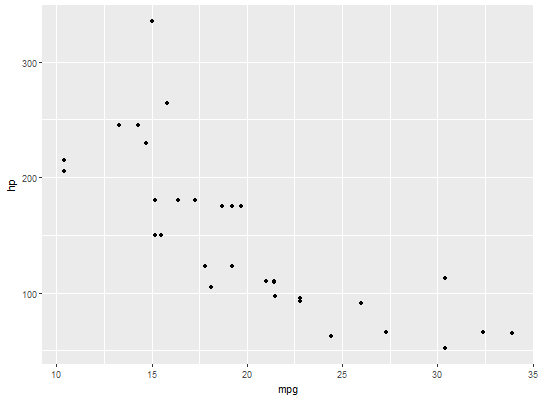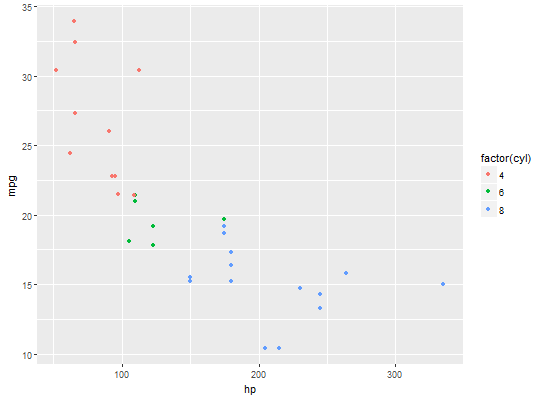Create ggplot plots in a loop.
ggloop() mimics ggplot() by accepting both a data frame and
mappings, returning a plot - or plots in this case. The main difference is
that ggloop() accepts vectors for aesthetics and returns a list or
nested list of ggplot plots.
ggloop(data, mappings = aes_loop(), remap_xy = TRUE, remap_dots = FALSE, gg_obs = TRUE, ..., environment = parent.frame())
Arguments
- data
- Default dataset to use for plot. Must be a data frame and can be only one data frame.
- mappings
- List of aesthetic mappings to use for plots. Works like
mappingfromggplot(). - remap_xy
- Remapping behavior of the
xandyvectors specified inaes_loop(). See details below for more on remapping behavior. - remap_dots
- Remapping behavior of the
...vectors specified inaes_loop(). See details below for more on remapping behavior. - gg_obs
- Logical. Specifies whether to return plots or the list (or nested list) of aesthetics used to make such a plots.
- ...
- Other arguments. Similar to
ggplot()'s.... - environment
- An environment and only one environment (cannot be a
vector). Similar to
ggplot()'senvironment.
Details
ggloop() makes use of aes_loop, which is meant to mimic
aes from ggplot2. Because of this, the remapping arguments are
supplied to ggloop instead of aes_loop().
The first remapping argument, remap_xy can take three values:
TRUE= The default behavior. All unqiue combinations ofxandyare generated. This means that if a variable (i.e.mpg) is supplied in bothxandy, then no mapping will havexandyvariables that are the same (i.e.x -> mpg; y -> mpgwill not ever happen). Likewise, no unordered pair duplicates will happen (i.e.x -> mpg; y -> cylandx -> cyl; y -> mpgwill be treated the same).FALSE= Ifxandyvectors are not the same length, then the shorter of the two will be recycled. Recycling is similar tomapply()'s recycling.NA= Ifxandyvectors are not the same length, then the shorter of the two will haveNAassigned to the missing elements. These are meant to act as placeholders during the wrangling operations (extracting and grouping the aesthetics), and will be taken out before the final list of mappings is sent toggloop().
Examples
# 1. Return all possible x-y combinations. plots <- ggloop(data = mtcars, mappings = aes_loop(x = mpg:carb, y = mpg:carb)) names(plots)#> [1] "x.mpg_y.cyl" "x.mpg_y.disp" "x.mpg_y.hp" "x.mpg_y.drat" #> [5] "x.mpg_y.wt" "x.mpg_y.qsec" "x.mpg_y.vs" "x.mpg_y.am" #> [9] "x.mpg_y.gear" "x.mpg_y.carb" "x.cyl_y.disp" "x.cyl_y.hp" #> [13] "x.cyl_y.drat" "x.cyl_y.wt" "x.cyl_y.qsec" "x.cyl_y.vs" #> [17] "x.cyl_y.am" "x.cyl_y.gear" "x.cyl_y.carb" "x.disp_y.hp" #> [21] "x.disp_y.drat" "x.disp_y.wt" "x.disp_y.qsec" "x.disp_y.vs" #> [25] "x.disp_y.am" "x.disp_y.gear" "x.disp_y.carb" "x.hp_y.drat" #> [29] "x.hp_y.wt" "x.hp_y.qsec" "x.hp_y.vs" "x.hp_y.am" #> [33] "x.hp_y.gear" "x.hp_y.carb" "x.drat_y.wt" "x.drat_y.qsec" #> [37] "x.drat_y.vs" "x.drat_y.am" "x.drat_y.gear" "x.drat_y.carb" #> [41] "x.wt_y.qsec" "x.wt_y.vs" "x.wt_y.am" "x.wt_y.gear" #> [45] "x.wt_y.carb" "x.qsec_y.vs" "x.qsec_y.am" "x.qsec_y.gear" #> [49] "x.qsec_y.carb" "x.vs_y.am" "x.vs_y.gear" "x.vs_y.carb" #> [53] "x.am_y.gear" "x.am_y.carb" "x.gear_y.carb"# [1] "x.mpg_y.cyl" "x.mpg_y.disp" "x.mpg_y.hp" "x.mpg_y.drat" # [5] "x.mpg_y.wt" "x.mpg_y.qsec" "x.mpg_y.vs" "x.mpg_y.am" # [9] "x.mpg_y.gear" "x.mpg_y.carb" "x.cyl_y.disp" "x.cyl_y.hp" # [13] "x.cyl_y.drat" "x.cyl_y.wt" "x.cyl_y.qsec" "x.cyl_y.vs" # [17] "x.cyl_y.am" "x.cyl_y.gear" "x.cyl_y.carb" "x.disp_y.hp" # [21] "x.disp_y.drat" "x.disp_y.wt" "x.disp_y.qsec" "x.disp_y.vs" # [25] "x.disp_y.am" "x.disp_y.gear" "x.disp_y.carb" "x.hp_y.drat" # [29] "x.hp_y.wt" "x.hp_y.qsec" "x.hp_y.vs" "x.hp_y.am" # [33] "x.hp_y.gear" "x.hp_y.carb" "x.drat_y.wt" "x.drat_y.qsec" # [37] "x.drat_y.vs" "x.drat_y.am" "x.drat_y.gear" "x.drat_y.carb" # [41] "x.wt_y.qsec" "x.wt_y.vs" "x.wt_y.am" "x.wt_y.gear" # [45] "x.wt_y.carb" "x.qsec_y.vs" "x.qsec_y.am" "x.qsec_y.gear" # [49] "x.qsec_y.carb" "x.vs_y.am" "x.vs_y.gear" "x.vs_y.carb" # [53] "x.am_y.gear" "x.am_y.carb" "x.gear_y.carb" plots$x.mpg_y.hp + ggplot2::geom_point()# 2. Add an additional aesthetic (facet) to plots. plots2 <- ggloop(data = mtcars, mappings = aes_loop( x = c(disp, hp, wt), y = mpg, color = factor(cyl))) sapply(plots2, names)#> color.factor(cyl) #> [1,] "x.disp_y.mpg" #> [2,] "x.hp_y.mpg" #> [3,] "x.wt_y.mpg"# color.factor(cyl) # [1,] "x.disp_y.mpg" # [2,] "x.hp_y.mpg" # [3,] "x.wt_y.mpg" plots2$`color.factor(cyl)`$x.hp_y.mpg + ggplot2::geom_point()# A look at remap_xy's other two behaviors: # 3. remap_xy = NA # The longer vector will go "unpaired" after the shorter vector # runs out of elements. plots3 <- ggloop(data = mtcars, mappings = aes_loop(x = c(mpg/disp, mpg/hp, mpg/cyl, mpg/gear), y = c(hp, disp)), remap_xy = NA) names(plots3)#> [1] "x.mpg/disp_y.hp" "x.mpg/hp_y.disp" "x.mpg/cyl" "x.mpg/gear"# [1] "x.mpg/disp_y.hp" "x.mpg/hp_y.disp" "x.mpg/cyl" "x.mpg/gear" # 4. remap_xy = FALSE # The longer vector will be "paired" with the shorter vector using # recycling (similar to R's internal recycling, i.e. mapply()). plots4 <- ggloop(data = mtcars, mappings = aes_loop(x = c(mpg/disp, mpg/hp, mpg/cyl, mpg/gear), y = c(hp, disp)), remap_xy = FALSE) sapply(plots4, names)#> x.mpg/disp_y.hp x.mpg/hp_y.disp x.mpg/cyl_y.hp x.mpg/gear_y.disp #> [1,] "data" "data" "data" "data" #> [2,] "layers" "layers" "layers" "layers" #> [3,] "scales" "scales" "scales" "scales" #> [4,] "mapping" "mapping" "mapping" "mapping" #> [5,] "theme" "theme" "theme" "theme" #> [6,] "coordinates" "coordinates" "coordinates" "coordinates" #> [7,] "facet" "facet" "facet" "facet" #> [8,] "plot_env" "plot_env" "plot_env" "plot_env" #> [9,] "labels" "labels" "labels" "labels"# [1] "x.mpg/disp_y.hp" "x.mpg/hp_y.disp" "x.mpg/cyl_y.hp" "x.mpg/gear_y.disp"

